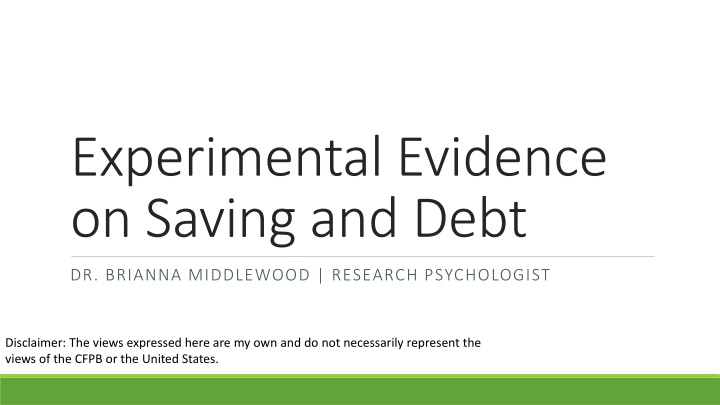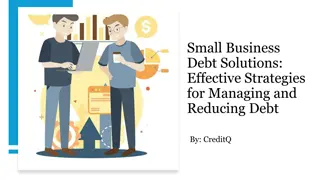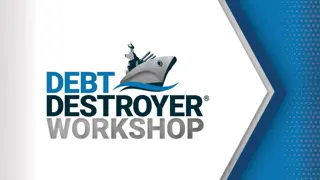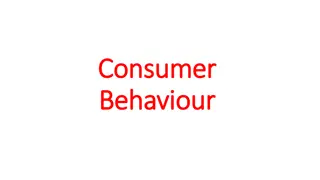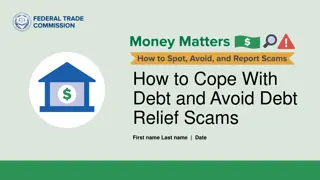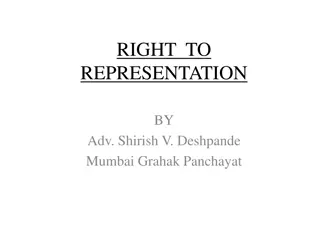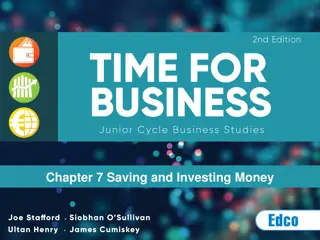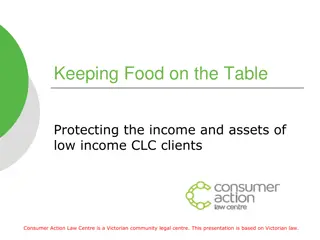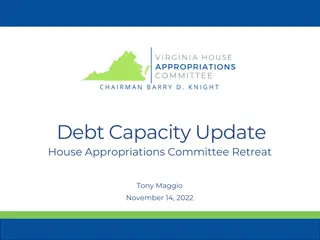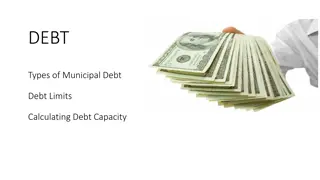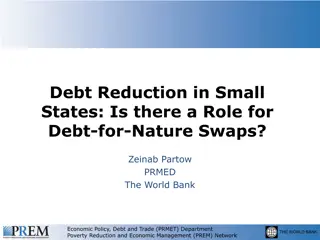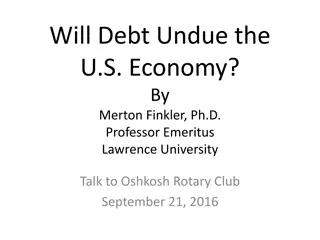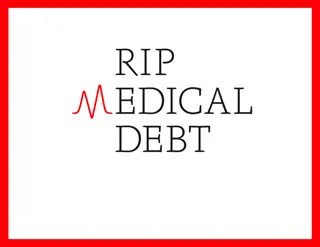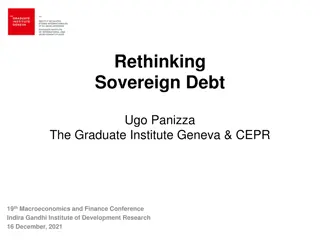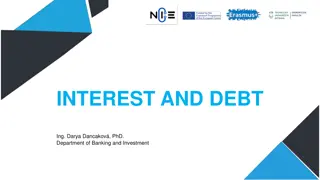Experimental Evidence on Saving and Debt: Insights into Consumer Behavior
Dr. Brianna Middlewood, a research psychologist, presents experimental findings on motivating consumers to pay down credit card debt by labeling debt as ordinary or exceptional. The research investigates if nudges based on mental accounts and norms influence repayment behaviors, revealing that people allocate more funds towards ordinary debt when it is labeled as such, indicating a potential strategy to encourage debt reduction. The studies highlight the impact of framing debt as ordinary or exceptional on repayment attitudes and behaviors.
Download Presentation

Please find below an Image/Link to download the presentation.
The content on the website is provided AS IS for your information and personal use only. It may not be sold, licensed, or shared on other websites without obtaining consent from the author.If you encounter any issues during the download, it is possible that the publisher has removed the file from their server.
You are allowed to download the files provided on this website for personal or commercial use, subject to the condition that they are used lawfully. All files are the property of their respective owners.
The content on the website is provided AS IS for your information and personal use only. It may not be sold, licensed, or shared on other websites without obtaining consent from the author.
E N D
Presentation Transcript
Experimental Evidence on Saving and Debt DR. BRIANNA MIDDLEWOOD | RESEARCH PSYCHOLOGIST Disclaimer: The views expressed here are my own and do not necessarily represent the views of the CFPB or the United States.
Problem Question Design & Sample Findings Answer Discussion
Labeling Debt as Ordinary versus Exceptional to Motivate Consumers to Increase Credit Card Repayments REMI TRUDEL SIMON J. BLANCHARD KERI L. KETTLE
Problem & Question Problem: There is a lot of credit card debt, and we d like people to pay it down. Question(s): Can we leverage what we know about mental accounts and norms to nudge people to pay down more of their credit card debt? 1. Specifically, do people find it less acceptable to use credit cards for ordinary, as opposed to exceptional, purchases? 2. And does this negative view lead consumers to pay more on ordinary balances when their ordinariness is pointed out?
Design & Sample STUDY 1 MTURK (N= 179) STUDY 2 STUDENTS (N = 240) All participants viewed hypothetical scenario with two credit cards One card with more ordinary expenses, one with more exceptional expenses. Outcome: Allocate $600 Participants assigned to 1 of 4 hyp. scenarios with one credit card: 2(Debt Type: more ord. or more exc. ) X 2 (Debt Labeling: yes, no) Outcome: Allocate $400 surplus
Design & Sample STUDY 3 MTURK (N = 125) STUDY 4 HELLO WALLET (N = 3777) Participants assigned to 1 of 2 cards, one card with more ordinary or exceptional majority of expenses Outcome: Is it ok that Alex has these types of expenditures when trying to get out of debt? Examined effect of unusual spending notifications conditional on the extent to which their debt was more exceptional (larger amounts) vs. ordinary
Findings Study 1, 2, 3: o People put more money toward ordinary debt when it is labeled as ordinary Study 3: o Alex has more financial control when his debt is ordinary o Less acceptable to have ordinary debt Study 4: o An unusual spending alert when most expenses are small increased repayment, but when most expenses are large decreased repayment
Answer Maybe yes! Participants did increase payments to ordinary credit card statement when it contained mostly ordinary expenses. They also did so when a statement was flagged as something that Alex would not be able to repay. Participants do find it less acceptable to have ordinary debt.
Discussion o There are alternative explanations for paying more on ordinary debt? The fact that most payments are ordinary signals that the card is used a lot. So, payments could be higher because people want to free up space on a card that is used a lot. Consistent with the finding that Alex has more financial control when his bill is more ordinary. P s may respond to this question thinking Alex uses a credit card for all spending with the intention of paying it off every cycle. o Participants view Alex s debt as a bill until it s labeled as debt? The payment questions in studies 1 and 2 sounds like people are just told about a credit card statement, so it s not clear whether it s debt. In study 3, P s are asked in the question is it okay that trying to get out of debt. So at that moment, you ve signaled to people that this is not just a bill, it s debt And the repayment question now is specifying that he can't repay (so he overspent on ordinary things) o o o
Discussion o Measuring the mediator Always the possibility that measuring something will result in an observed effect of that thing, so measuring alternatives and manipulating the mediator in follow-ups is important o Hypotheticals Do people tend to know how their own spending is shaking out in terms of ordinary versus exceptional? Interested in how consumers define ordinary vs. exceptional, and whether that is something that is subject to context or motivated reasoning. Is ordinary debt better defined qualitatively or in terms of relative size, as in S4?
o Is it your credit card balance? Statement? The amount left over after you make your payment? o Does it depend on whether you could pay off the whole thing, but you choose not to? How is this different from closed- ended credit? What is credit card Debt? Open-ended debt is psychologically interesting. In the absence of firm rules for how to pay it down, consumers use their own rules, which are subject to social and emotional contexts.
Does Saving Cause Borrowing? PAOLINA MEDINA MICHAELA PAGEL
Problem & Question Problem: We want to nudge people to save more, but there s a risk that this ultimately results in some people taking on more debt. Question(s): Does nudging people to save ultimately mean they take on more debt to meet expenses? Might this effect be stronger for certain groups, like those who tend to co-hold savings and debt at the same time?
Design & Sample Customers of Banorte, a Mexican bank 3,054,438 Control Treatment 374,893 7 savings nudges Weekly Biweekly
Answer o No, nudges to increase savings amounts do not appear to lead to increased borrowing. o A decrease in discretionary spending likely underlies the observed increase in savings for the treatment group o As opposed to taking on more credit card debt.
Discussion o It s tough with small treatment effects to evaluate whether the treatment is harmful. o Really cool idea to try to tackle this issue using machine learning to identify what seem to be the most treated groups or the groups that are most likely to be harmed.
o This question motivates a lot of cool research, but o What about removing barriers to savings products or creating new products to help people save more easily? o Bureau is forming partnerships with Fintech companies to learn about new products Why don t Why don t people people make themselves save more moreeven when it s super unreasonable to expect them to? ? save o What about interventions that reduce the cost of banking services? o This report says vulnerable households spend 13% of their income in 2020 on fees and interest related to everyday financial services
Bureau Research: Balancing Savings and Debt When asked if savings should be used to pay down credit card debt, people think that a good chunk should go to debt (~60%), but that another chunk of savings should be retained. This is true even if the credit card debt exceeds the savings by quite a lot, even if the savings is twice the amount of the debt.
